
The Things We Keep: The Enduring Power of Shoshanna Fink's "Marked"
Published July 28th, 2025 by Laura Laptsevitch
In her latest exhibition at Form+Content, artist Shoshana Fink explores the human impulse to mark space and the ways those marks help us remember.
Why do we keep the things we do? I asked this to Shoshana Fink, seeking to understand her photographs of teeth—baby teeth, adult molars, and a giant gold crown. I told her my mother had saved my baby teeth in a little envelope in a baby book. I thought I was alone in this experience, but Fink said, “I have my daughter’s first tooth and hair.” We were both surprised at how many people kept teeth.
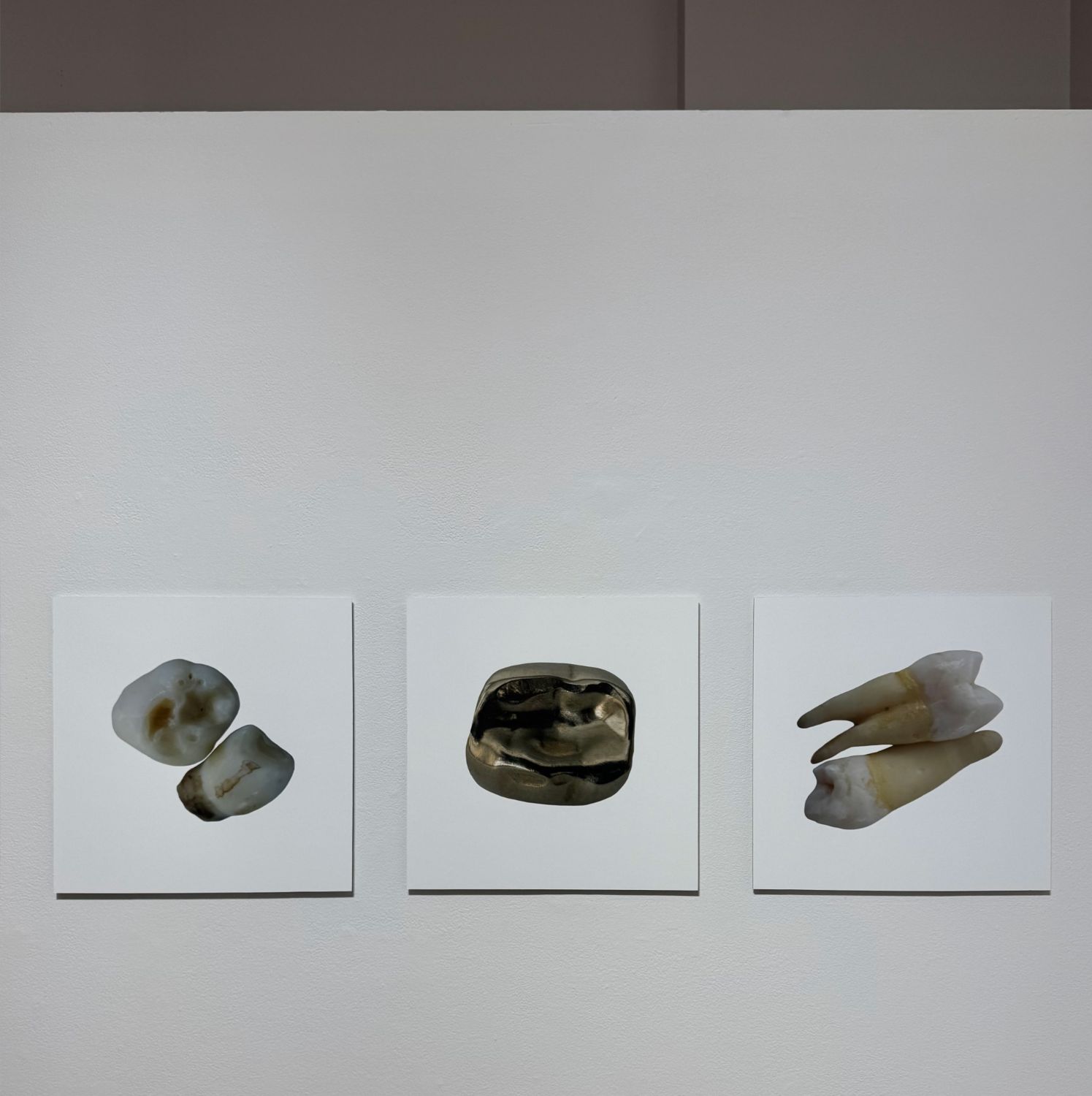
Gallery view, Bitemarked, archival pigment prints mounted on aluminum composite (Dibond). Human teeth courtesy of Sarah Stojevich and Susan Hart-Gaines. Gold dental crown courtesy of Elaine Handelman. Dimensions: 16” x 16”.
You can find bits of hair in The Things We Carry, a row of heart-shaped lockets to the right of her tooth photographs (Bitemarked). Some are open, others are closed; some contain hair, human remains, photographs and mirrors.

Gallery view, The Things We Carry, metal and glass heart-shaped lockets, photographs, baby blanket fragments, feathers, and miniature dollhouse silverware from the artist’s archive. Bio-materials including robin’s egg, bumble bee, human hair. Cremated human remains courtesy of Susan Hart-Gaines.
Why do I keep things? I can’t help but wonder. When I think about the things I can’t part with, what comes to mind are birthday cards. I have a drawer full of them and feel hesitant to throw any away. As if doing so might offend the sender—two, three, or even ten years later.
Marked speaks to this impulse to keep and preserve; on view at Form+Content Gallery, Marked is a multi-sensory and interactive installation with sculpture, photography, sound, touch, and scent. In her first solo show at the gallery, Fink explores the human tendency to mark space and the lasting traces those marks leave behind. Talking with Fink, I couldn’t help but feel this show was deeply personal. “The whole thing is a self-portrait,” she told me. “An elaborate self-portrait.”
While Marked explores many themes, memory stands out as the most compelling. Our experiences are archived as memories and stored in the unconscious, an imperfect and unpredictable technology. Fink and I talked about how memories get fragmented over time, especially as we get older.
Time is strange. Memories often tell us that time doesn't exist. “This feels like it was just yesterday” is a phrase etched into the human lexicon. Certain moments take us out of time—finding an old letter, hearing a song at the mall, smelling a once-familiar hair product, tasting a childhood meal; it unlocks something no one knew was there. These moments transcend past and present into the here and now.
Standing in the gallery, Marked demands presence.
As a photographer, Fink understands the power of the present. When I asked her about the role of photography, she said, “It’s so good at capturing the now,” emphasizing its close connection to memory. “It’s the immediacy and urgency of it,” she added. Few mediums preserve as effectively as photography.
While photography captures and preserves, memories inevitably fade. I've noticed, though, that certain smells have a remarkable ability to bring back once-forgotten memories.
Fink incorporates scent in The Life of a Rose, three artist-designed rose scents in vintage green glass jars. It includes a fresh rose, a wilting rose, and a dead rose. She tells me that throughout her life, roses have consistently appeared at significant events, from birthdays to bat mitzvahs. Besides her Hebrew name being "Rose", this piece has a personal tie to her father. Fink explained, “My Dad died in 2021 with Alzheimer’s. We went to the rose garden and he could still smell the roses and flowers.” Despite the advanced stage of his illness, he still recognized the smell of roses.
I noticed this “resurfacing” of memories in real time stepping into Fink’s installation: What We House, What Houses Us, an unfinished house. People often say that art can transport you to another place, but for me this wasn’t a platitude. It was a portal to Abilene, Texas, circa 2005.
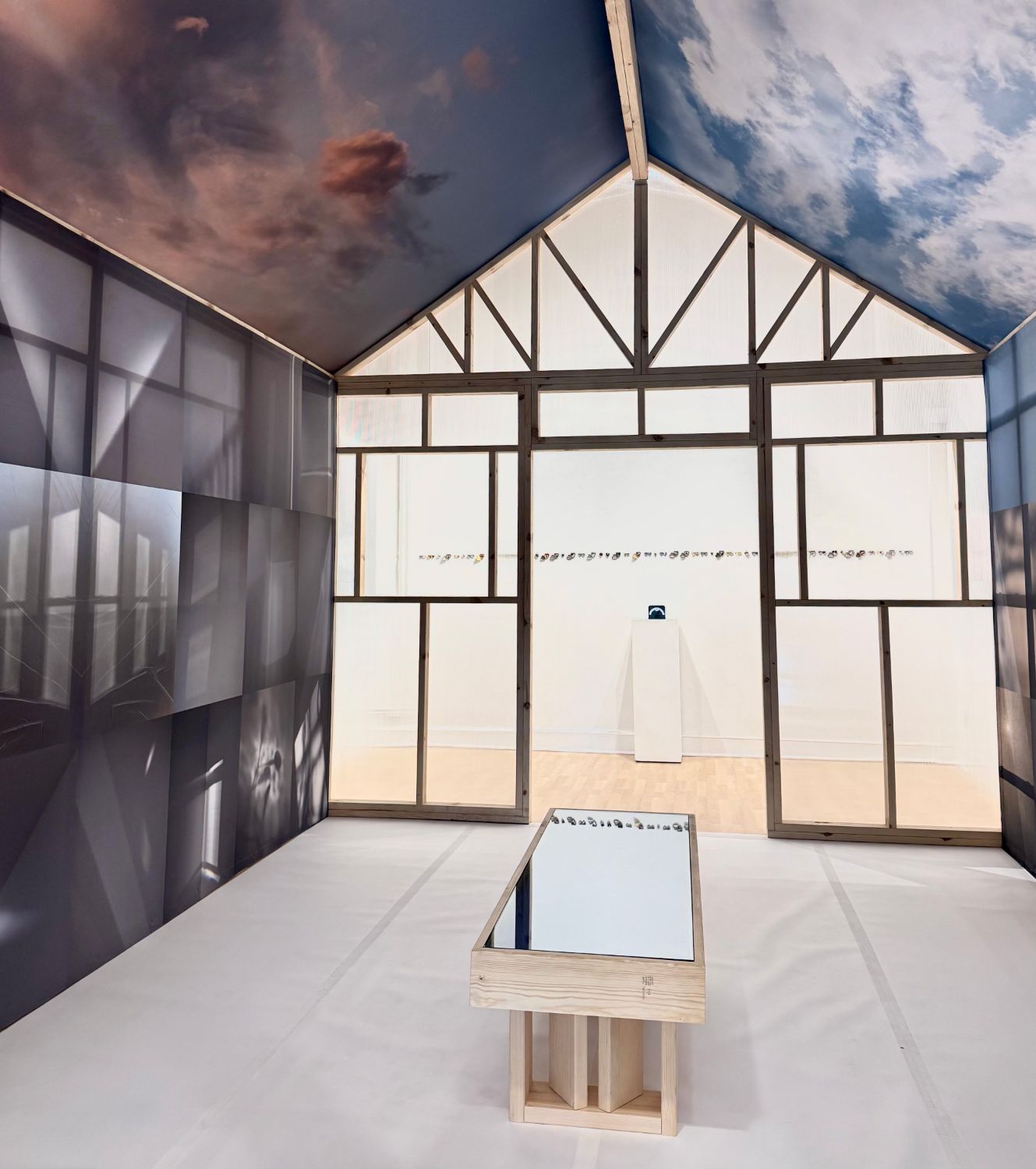
Gallery view, What We House, What Houses Us, 2” x 4” #2 premium grade pine wood, and thermo-clear multiwall polycarbonate sheeting (Lexan). 12’ x 16’7” x 12’.
After moving across the country from Washington, D.C., my family and I found ourselves in a flat, dusty, cactus-filled stretch of rural America. Our house sat in a new development, surrounded by cul-de-sacs and half-built homes. For fun, my sisters and I would explore the unfinished houses, bare drywall, beams, and insulation. What took me back was the very specific, potent smell of southern spruce pine. When I walked into Shoshana’s “house,” the pieces came together. The look, the smell—it was identical to those homes we once rummaged through. I remembered.
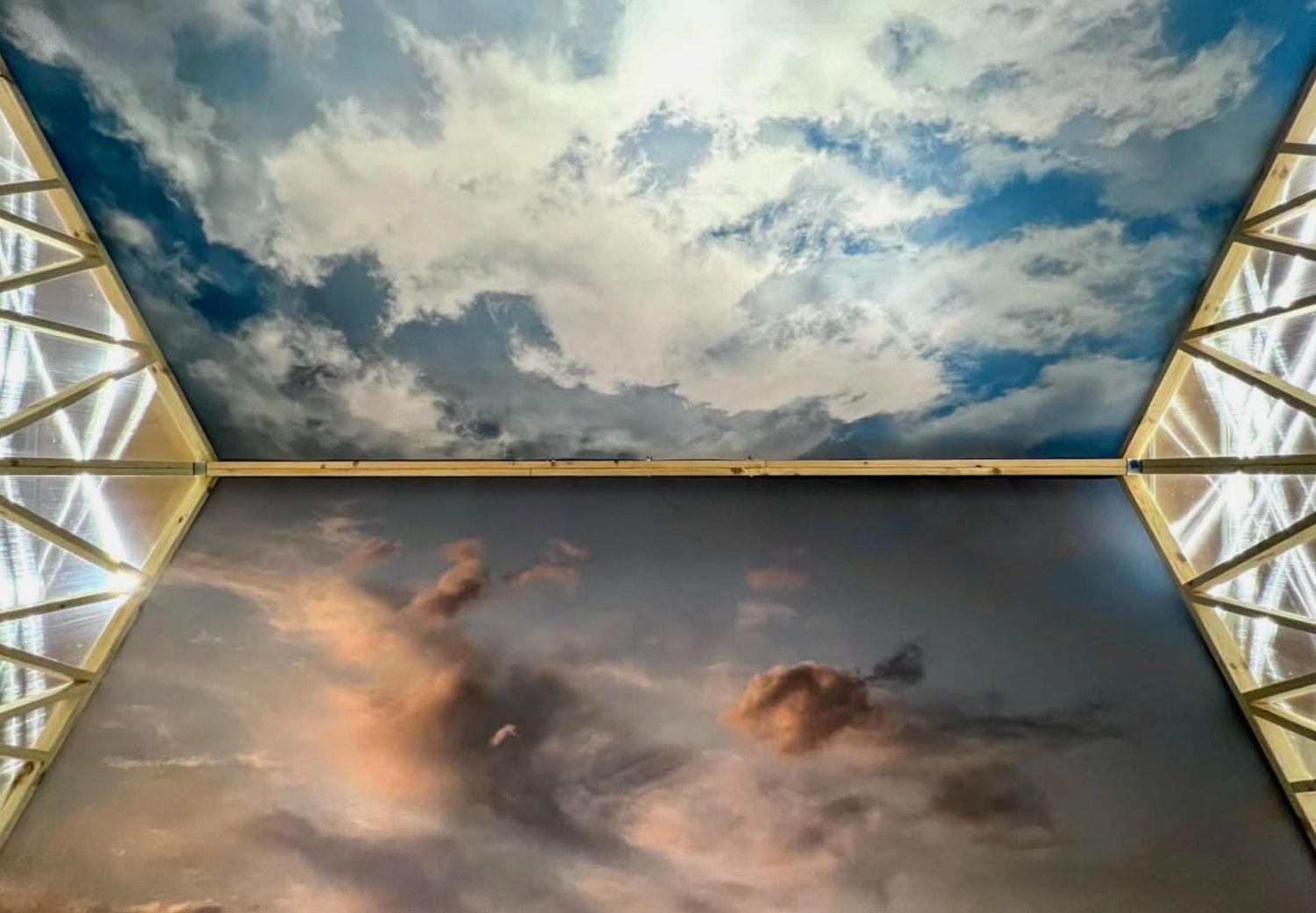
Gallery view, top to bottom, Midday Sky, photographic mural printed on 9-ounce matte backlit IFR fabric. Dimensions: 7’2” x 16’7”. Sunset Sky, photographic mural printed on 9-ounce matte backlit IFR fabric. Dimensions: 7’2” x 16’7”. Courtesy of Form+Content Gallery
The photos, coupled with the familiar smell, took me out of my body. The response was so powerful that I gave in to the urge to lie down and watch Midday Sky, and Sunset Sky, pass as if they were real. How many other people have seen these same clouds? I wondered.
Underneath Midday Sky and Sunset Sky is a bench marked by handprints and footprints molded in bio-foam, sealed beneath half-inch safety glass, and layered with flat black latex and blue spray paint—a very distinct Klein blue.

Detail, Birthmarked, archival pigment prints mounted on aluminum composite (Dibond), 16” x 16”
To my left and right were Dawn to Dusk and Sun Paintings, respectively. Viewing Dawn to Dusk, I felt a strange sense of in-and-out-ness. Like the suspended awareness that comes from staring out a window or watching a shadow move across the wall. Your body’s in one place, your mind somewhere else.
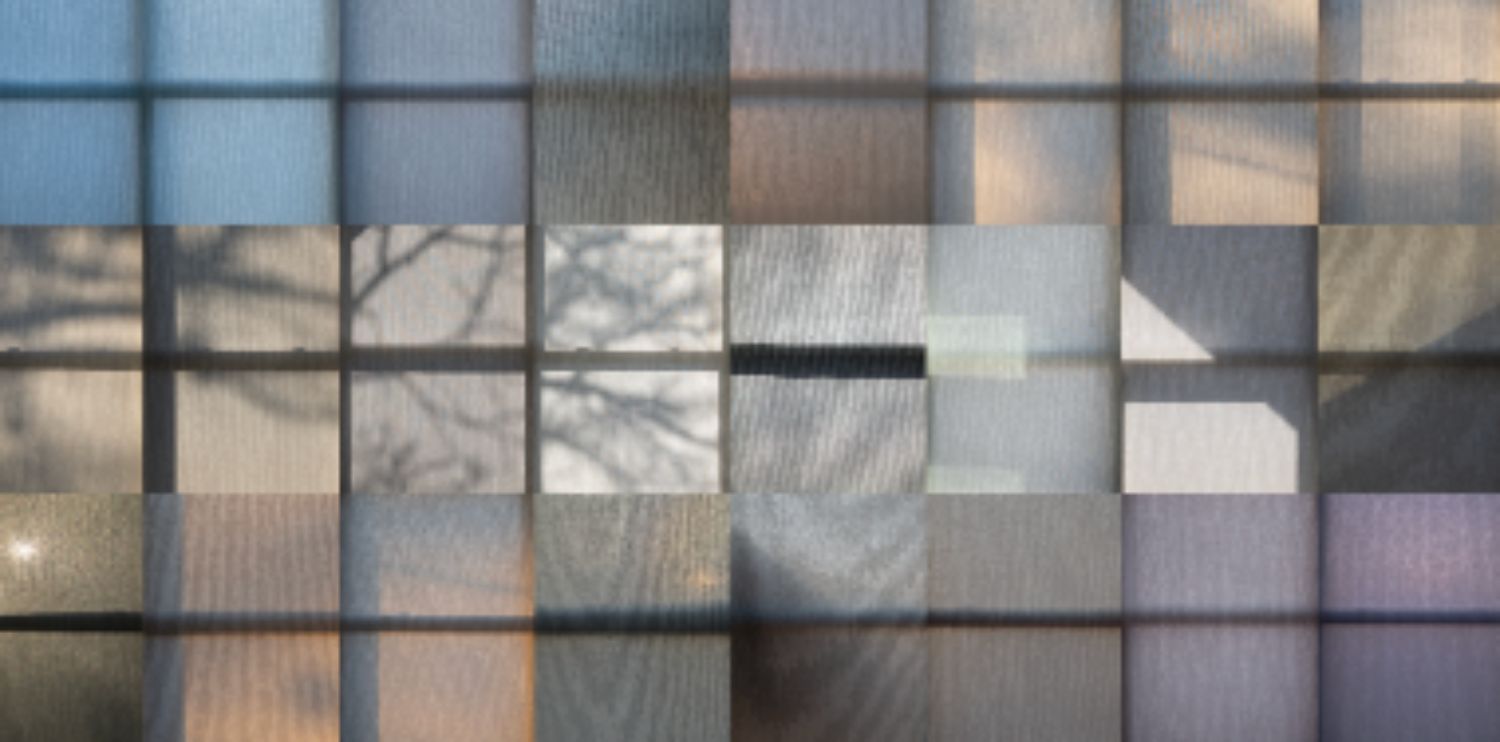
Dawn to Dusk, photographic mural printed on 9-ounce matte IFR fabric. Dimensions: 8’ x 16’. Image courtesy of the artist.
Dawn to Dusk specifically reminds me of film. I felt like I was watching a movie, reflecting on bookmarked moments of my life from the vantage point of an audience member. Perhaps it's because the frames repeat, with that grounding horizontal line.
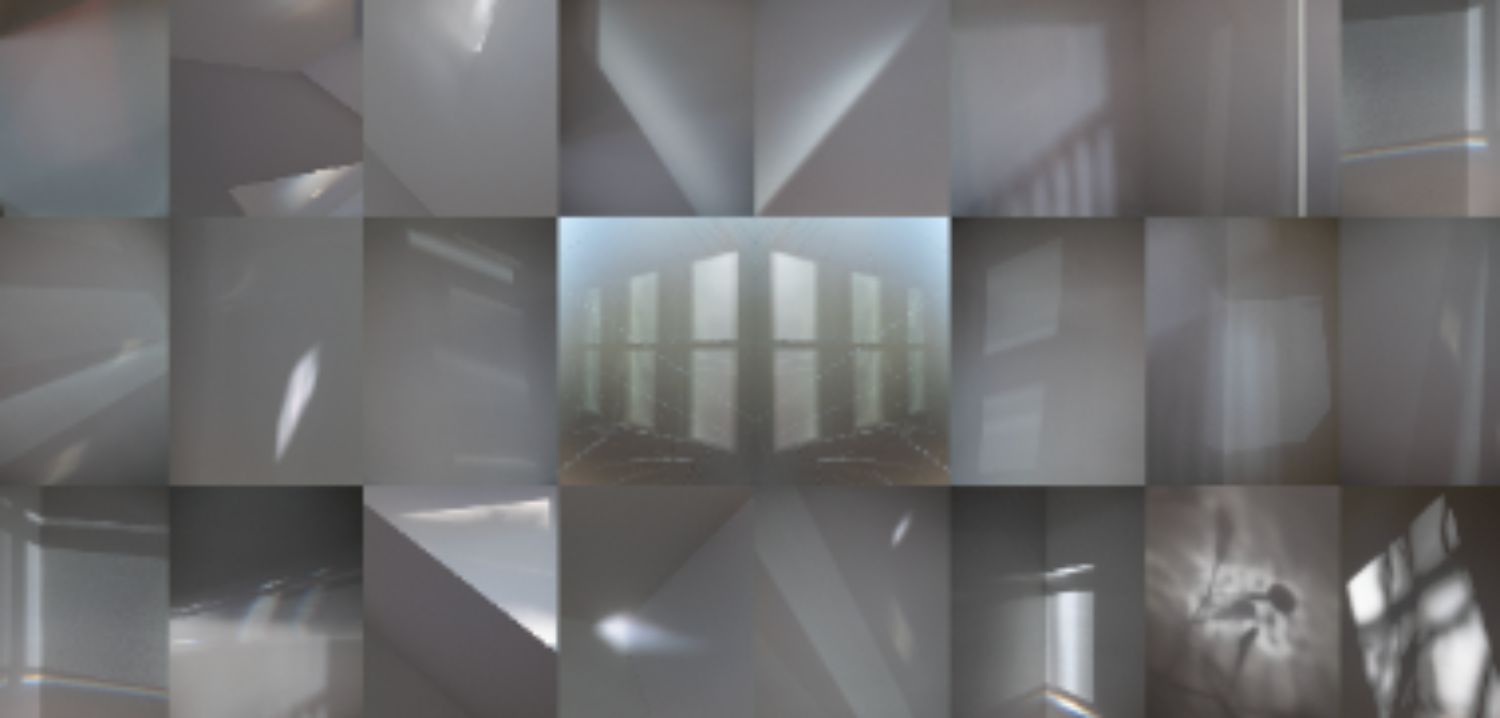
Sun Paintings, photographic mural printed on 9-ounce matte IFR fabric, 8’ x 16’. Image courtesy of the artist.
Sun Paintings feel different. The story is nonlinear, there are many diagonals, and there is a little bit of magic in the bottom right corner. Light bounces between frames and ricochets off surfaces. It’s not about the window’s light source, but about how that light spreads, refracts, and fills space. It feels slightly ominous, yet playful and harmless.
“Your images strike me as vulnerable,” I tell Fink.
She pauses, then responds, “I spend a lot of time thinking and feeling a place or a person, trying to reflect the energy of the place or person.” Fink continues, “I went to Berlin last fall and saw a show by Mark Bradford. He had an interview about the work, and one of the things he said was ‘I try to be vulnerable in my work, and share my vulnerability with the viewer, because I feel that's one of the ways we connect as human beings.’ When I feel it's not there, I don’t connect with the work.”
“What do you want people to take away from the show?” I ask. “I want people to be moved in some way,” Fink shares.
This emphasis on connection is what makes this show so deeply human.
When I think about what it means to be human, I think of the people we touch. Of course, we leave memories, but we also leave behind things. Jewelry, family heirlooms, handwritten notes. Sometimes, strangely, parts of our bodies: hair, teeth.
Amid the sensory overload and the emotional weight of the show, I couldn’t help but ask: why? Why do we keep things?
I once went to Duluth with my partner and wrote our names on the concrete railing surrounding a famous lighthouse. Along with thousands of other couples, we felt compelled to leave something behind. We did the same in a park in St. Paul. I went back later, hoping to find our names, but couldn’t. I told myself that if our names were still there, the memory must have been real.
This is why we mark the land—with graves, monuments, and arches in the sky. It’s why we left handprints on cave walls. We carve memories into stone because memory alone isn’t enough. We need something tangible. We need presence.
In Marked, Fink reminds us that to mark is to remember, and to remember is to affirm that we were here. Be it a scent, a photo, or marking height on a door frame, our impulse to leave something behind feels both natural and mysterious. It’s primal, tender, and human.
This show doesn’t just ask us to look; it asks us to feel, to return, and to witness how the traces we leave behind outlive us, quietly insisting… This mattered. ◼︎
Marked is currently on view at Form+Content Gallery through August 23rd, 2025. Gallery Hours are Thursdays, Fridays, Saturdays 12-6pm. Join the artist for an artist talk at the gallery Sunday, August 3rd 2-3pm. You can see more of the artist's work on her website.
We can't do it without you.
Help keep independent arts journalism alive in the Twin Cities.